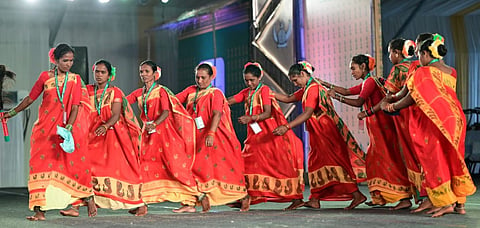
- Destinations
- Experiences
- Stay
- What's new
- Editor’s Picks
- Responsible Tourism
- CampaignsCampaigns
- Subscribe

The National Tribal Dance Festival in Raipur, Chhatisgarh, concluded on November 3 with the tribal artists and troupes being awarded for their exceptional performances. In addition to international performers, tribal artists from different states, including Uttarakhand, Maharashtra, Nagaland, and Andhra Pradesh, among others, won the hearts of the local people, who cheered for them amid loud slogans of "Chhattigarhia, sab le badhiya" Here's a brief look at some folk dances that impressed the audience.
Uttarakhand Harul
The Jaunsar community in Uttarakhand has long performed folktales based on the Mahabharata. They do the Harul dance, in which a person riding an elephant swings an instrument resembling an axe and scatters grains and flowers on crowds as a sign of fortune. The Ramtula, a unique instrument to the dance, adds to the harmony of this traditional folk dance.
Maharashtra Songi Mask Dance
The rich folk dance-music heritage of India is best exemplified by the Songi Mask dance of Maharashtra, which is usually performed on the full moon day of Chaitra month. Two entertainers dance as Narasimha in this dance, and others perform sporting Betal and Kaal Bhairav masks. This dance represents the triumph of truth. The major musical instruments utilised in this dance are the dhol, pavri, and sambal.
Andhra Pradesh Dhimsa
Andhra Pradesh's tribal dance is usually executed by roughly 15-20 women, even though both men and ladies of any age can participate. It is customary to do this dance on Dussehra and other ceremonial events, in addition to the occasion of marriage. The dancing girls dress in vivid red, green, pink, and yellow saris and accessorise with garlands around their necks. Men play distinctive tribal musical instruments like kiridi, mori, dappu, tudumu, and jodukomulu.
Nagaland Maku Himisi
A bravery dance performed after winning the battle, the Maku Himisi sees artists dance with swords and spears in their hands. The beats of the instruments used in the dance and the echo of music are heard far away. Furthermore, the male dancers wear cap hats similar to Roman soldiers.
Maharashtra Dhangari Gaja
The Dhangari Gaja folk dance represents the process of appeasing Goddess Parvati when she becomes enraged. The main draw of this traditional dance is a procession of dancers holding exquisitely embellished flag umbrellas. Sangli's folk artists have performed this dance for generations. The dialogue between Shiva and Parvati and the numerous folktales based on it are typical in folk life.
